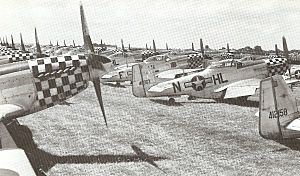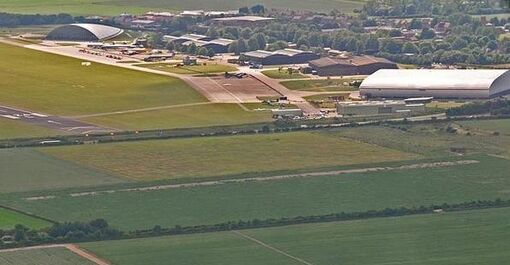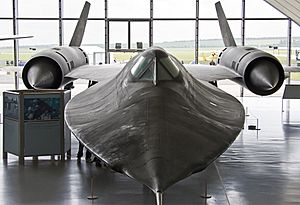Imperial War Museum Duxford facts for kids
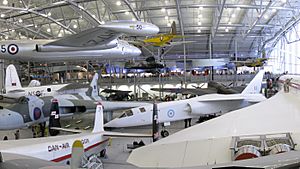
The AirSpace exhibition hall at Imperial War Museum Duxford (October 2009)
|
|
| Lua error in Module:Location_map at line 420: attempt to index field 'wikibase' (a nil value). | |
| Established | 1977 |
|---|---|
| Location | Imperial War Museum Duxford Cambridgeshire CB22 4QR United Kingdom |
| Type | Aviation museum |
| Visitors | 401,287 (2019) |
| Public transit access | |
| Imperial War Museums | |
|
|
Imperial War Museum Duxford, also known as IWM Duxford, is a large museum in Cambridgeshire, England. It is part of the Imperial War Museum family. Duxford is Britain's biggest aviation museum, home to almost 200 aircraft, military vehicles, and other historical items.
The museum is built on the historic Duxford Aerodrome, which was an active airfield during both the First World War and the Second World War. It played a key role in the Battle of Britain. After the airfield closed in 1961, the Imperial War Museum took it over in 1976.
Many of Duxford's original buildings, like the hangars from the Battle of Britain, are still used today. Some of these buildings are very old and important. The museum also has new buildings, such as the American Air Museum, designed by famous architect Sir Norman Foster. Duxford is still an active airfield and hosts exciting air shows regularly.
Contents
History of the Museum
The Imperial War Museum started in 1917 during the First World War. Its goal was to record Britain's war efforts. After the Second World War, its mission grew to include all modern conflicts involving British forces. This meant the museum's collection, especially large items like aircraft and vehicles, grew too big for its London home.
In 1969, RAF Duxford, a Royal Air Force base, was no longer needed. The museum asked to use one of its large hangars for storage. Soon, ten aircraft were moved to Duxford and volunteers began restoring them. The museum held its first airshow in 1973. These shows became very popular, attracting thousands of visitors and raising money.
Because of this success, the entire Duxford site was given to the Imperial War Museum in February 1976. It became the museum's first "outstation" or branch. Duxford quickly became a popular attraction, welcoming millions of visitors over the years.
In 2021, the museum considered lending some land vehicles to another museum. In 2024, it announced that the Land Warfare Hall permanently closed. A major renovation of the AirSpace hangar began in 2025. Over 100 aircraft are being moved as part of a plan to create a new exhibition about the Cold War.
Duxford Aerodrome's Past
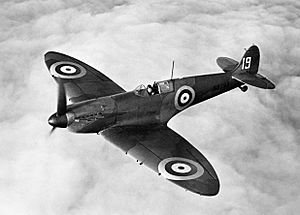
Duxford has been linked to British military aviation since 1917. It started as a training airfield for the Royal Flying Corps. From 1925, Duxford became a fighter airfield. In 1938, No.19 Squadron RAF at Duxford was the first to fly the famous Supermarine Spitfire.
During the Second World War, Duxford was very active in the Battle of Britain in 1940. Later in the war, special units worked there. In 1942, the first Hawker Typhoon Wing was formed at Duxford.
In 1943, the United States Army Air Forces' 78th Fighter Group arrived at Duxford. They flew Republic P-47 Thunderbolts and later North American P-51 Mustangs. They flew missions to protect bombers and attack enemy targets until the war ended.
Duxford returned to the RAF in 1945 but closed as an active airfield in 1961. The site became run down. In 1968, a film studio used the site to film Battle of Britain. A hangar was even knocked down for the movie to look like an air raid.
Duxford Aviation Society

Duxford is run by the Imperial War Museum, Cambridgeshire County Council, and the Duxford Aviation Society. This society is a charity that helps educate the public by collecting and showing historic aircraft, military vehicles, and boats. They also support the Imperial War Museum.
The Society was formed in 1975. They look after the Civil Aviation Collection at Duxford. Important aircraft in their collection include a de Havilland Comet. This plane made the first jet-powered flight across the Atlantic Ocean from east to west in 1958. They also have Concorde G-AXDN 101, a test aircraft that flew faster than any other Concorde.
The Society's Military Vehicle Wing has a team of experts who restore military vehicles. They own some vehicles at Duxford and fix others for the museum. They also drive vehicles for demonstrations during the year.
Other parts of the society help with things like the canteen, aircraft care, and learning activities. The Duxford Radio Society collects and shows old military electronic equipment. Many of the society's members are volunteers, helping the museum run smoothly.
Air Shows and Flying

Duxford is still an active airfield with two runways: a grass strip and a concrete runway. The Imperial War Museum bought the runways and surrounding land in 2008.
Since 1973, Duxford has held regular air shows. Several private aviation companies are based at Duxford. They offer pleasure flights, provide historic aircraft for films, and restore planes. One famous plane based here is Sally B, the only B-17 Flying Fortress that can still fly in Europe.
Major air shows include the Duxford Air Show and American Air Day. The American Air Day is held with the United States Air Forces in Europe. These shows display many types of aircraft, from old warplanes to modern jets. They also feature amazing aerobatic flying by groups like the Red Arrows.
Air shows bring in a lot of money for the museum. Duxford has its own Fire Service to ensure safety, with vehicles and firefighters ready for any event.
Museum Layout
Duxford museum is divided by the A505 road. The north side stores the museum's collections and is not usually open to the public. The south side has the hangars, historic buildings, and runways for visitors.
The visitor entrance used to be the airfield's armoury. The main buildings are lined up roughly parallel to the A505 road. AirSpace is on the east, followed by Hangars 2, 3, 4, and 5, then the American Air Museum. The museum site is about 1,800 meters long, so a visitor bus helps people get around.
Some aircraft and other exhibits are displayed outside. For example, a Comet tank and a replica Hawker Hurricane are at the main entrance. A Bristol Bloodhound missile stands where an old hangar used to be. A Royal Engineers' Centurion tank is outside the Land Warfare Hall, and a large 9.2-inch artillery gun from Gibraltar is nearby.
Many of Duxford's buildings are very important historically. Over thirty buildings have "listed building" status, meaning they are protected. This includes three hangars from the First World War and the operations block. The operations block, which visitors can see, was where Duxford's aircraft were directed during wartime. Another historic building, the 1918 Watch Office, now shows the Historic Duxford exhibition, telling the story of the site and the people who worked there.
AirSpace Exhibition
In 2000, Duxford planned to make Hangar 1, also known as the 'Superhangar', much bigger. This would create more space to display and care for the museum's British and Commonwealth aircraft collection. The project cost £25 million and was supported by various groups.
AirSpace officially opened on 12 July 2007. It has 12,000 square meters of space. It includes an aircraft care area, a large exhibition hall, and a viewing level. From here, visitors can see the aircraft and learn about how planes fly.
Over 30 aircraft are on display, some dating back to the First World War. These include rare planes like an Airco DH.9 and a Royal Aircraft Factory R.E.8. More recent planes include a Hawker Siddeley Harrier from the Falklands War and a Panavia Tornado that flew many missions in the 1991 Gulf War. Also on display is a British Aircraft Corporation TSR-2 strike aircraft, one of only two left. A Eurofighter Typhoon was added in 2009. Civilian aircraft include the Duxford Aviation Society's Concorde and Comet.
Airborne Assault Museum
AirSpace also houses Airborne Assault, which is the museum for the British Army's Parachute Regiment and airborne forces. This museum opened at Duxford on 8 December 2008. It tells the story of British airborne forces from the Second World War to recent operations in Afghanistan.
Hangar 2: Flying Aircraft
Hangar 2 is a large hangar built in the 1970s. It is home to the aircraft that can still fly, owned by Duxford's private aviation companies. Visitors can often see aircraft being fixed or restored here.
Hangar 3: Air and Sea
Hangar 3 is an original historic hangar. It displays Duxford's collection of boats and naval aircraft. Boats on display include Coastal Motor Boat 4, which saw action in 1918–19. Its commander won a Victoria Cross for sinking a Russian cruiser. Other vessels include a motor torpedo boat, a tiny midget submarine, and a wartime Royal National Lifeboat Institution boat.
Various naval aircraft are also shown, such as a de Havilland Sea Vixen, Sea Venom, and Sea Vampire. A Westland Wasp helicopter that served in the Falklands War is also here.
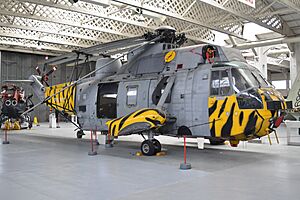
Hangar 4: Battle of Britain Exhibition
Hangar 4 is another historic hangar. It has an exhibition about Duxford's history as an RAF airfield, from the First World War to the Cold War. Early aircraft like a Bristol F.2 Fighter are shown. Later planes include a Hawker Hunter and a Gloster Javelin, which made the last operational flight from Duxford in 1961. A Hungarian Air Force MiG-21, a common jet fighter from the Cold War, is also on display.
The exhibition especially highlights Britain's air defence during the Second World War. It covers the Battle of Britain and the V-1 flying bomb attacks. A notable aircraft is a Messerschmitt Bf 109E that crashed during the Battle of Britain. It is displayed as if it has just crashed, with guards around it. An unusual aircraft is the Cierva C.30A autogyro, which was used to test radar units.
Hangar 5: Conservation in Action
Hangar 5 is the westernmost original hangar. It holds Duxford's aircraft conservation workshops. Visitors can watch museum staff and volunteers working on various restoration projects.
Important projects have included a Mitsubishi A6M Zero fighter found in 'jungle recovery' condition. Another was a Royal Aircraft Factory R.E.8, now displayed in AirSpace. Duxford also helps train volunteers for aviation heritage projects. Recent projects include restoring a Handley Page Victor and a Vickers Valiant bomber.
American Air Museum
Since the late 1970s, the museum has collected important American aircraft. These include a Boeing B-17 Flying Fortress, a Boeing B-29 Superfortress, and a Boeing B-52 Stratofortress. Because Duxford was linked to the US Army Air Forces (USAAF) during the war, plans began in the mid-1980s to remember America's role in the Second World War.
A group of American supporters was formed, and architect Norman Foster designed a new building. Fundraising started in 1987, with support from many people in the United States. The project also received funding from Saudi Arabia and the Heritage Lottery Fund. Construction began in 1995.
Building the Museum
The American Air Museum was designed by Norman Foster. The museum needed a special building to hold its aircraft collection. It had to be big enough for the museum's B-52 Stratofortress bomber, which has a 61-meter wingspan and is 16 meters tall.
The roof is shaped like a curved concrete shell, 90 meters wide and 18.5 meters high. It weighs 6,000 tonnes and can hold suspended aircraft weighing up to 10 tonnes. A large glass wall lets in daylight and allows visitors to see planes outside. It also means visitors inside can watch aircraft landing or taking off. The building won a major award, the 1998 Stirling Prize.
Opening and Dedication
The American Air Museum was opened by Queen Elizabeth II on 1 August 1997. The project cost £13.5 million. The museum was re-dedicated in 2002, with Prince Charles and former President George H. W. Bush attending.
Since opening, the glass front has been temporarily removed to bring in very large aircraft. These include an SR-71 Blackbird, the only one of its kind outside the United States. It set a flight altitude record in 1976.
Nineteen other American aircraft are on display. Notable examples include a C-47 Skytrain that took part in the Normandy landings and other major operations in the Second World War. The museum's B-29 flew during the Korean War. The B-52 flew 200 missions during the Vietnam War. A General Dynamics F-111 on display flew missions during the 1991 Gulf War.
In 2014, the museum received funding to create a website based on the photos of aviation historian Roger A. Freeman. The website, americanairmuseum.com, launched in October 2014. It collects photos and information from the public about American airmen who served from the UK in the Second World War.
North Side: Collections Storage
The 'North Side' of Duxford, north of the A505 road, is used to store the Imperial War Museum's collections. This includes film reels, some on highly flammable nitrate film, kept in special vaults. Other collections stored here include books, maps, photographs, documents, uniforms, and equipment.
Images for kids
See also
 In Spanish: Museo Imperial de Guerra de Duxford para niños
In Spanish: Museo Imperial de Guerra de Duxford para niños


